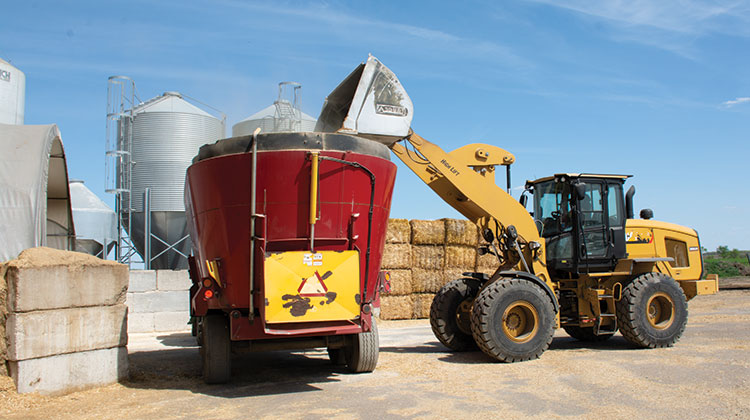
Proper mixing of dairy rations is one of the key jobs on a dairy farm operation. It is crucial to carefully manage this process. Feeding is not only responsible for approximately 60% of your farm’s expenses (in feed costs, resources, and equipment), but it is also one of the major contributors to cows’ health and productivity.
When evaluating feeding programs, one of the questions that consistently fails to receive analysis and discussion is where the mixer wagon is located (parked) when ingredients are added and mixed. Repositioning the mixer wagon can significantly reduce feed shrink, one negative contributor to farm profitability. According to Mike Brouk, an extension specialist from Kansas State University, 12% average feed shrink can cost a 500-cow dairy around $165,000 a year.
Three areas to evaluate
What factors should be considered? Proximity to ingredients, environmental exposure, and terrain slope should be reviewed when evaluating where the mixer is placed in each step of the mixing process.
Proximity: Is the distance traveled by the front loader or skid steer optimal? Could it be reduced? The distance traveled can negatively impact the efficiency of the mixing procedure.
Feeding time, shrink, and costs of feeding can all be improved by reducing the distance traveled by your feed and equipment every day. In one case study, equipment expert Allen Bonthuis was able to reduce the loading time of one bucket load by 4.3 seconds by simply adjusting the location of the equipment. Considering the number of buckets that are loaded every day (especially if mixing with a skid steer), 4.3 seconds per bucket can translate to a significant reduction in mixing time.
Time equals money. Running time requires gas and maintenance, depreciates equipment, and contributes to labor cost. If we use a generic setup of a tractor, mixer, and front-wheel loader, we can conservatively estimate that the operating cost ranges from $85 to $100 per hour. Thus, reducing one hour of feed assembly time per day through multiple changes can add up to $36,500 in cost savings each year.
Additionally, limiting both the number of transfers and distance traveled by feed will reduce the opportunity of shrink due to environmental exposure.
Exposure: Is your wagon exposed to environmental elements such as wind, rain, and dust, among others? This can have a negative effect in the precision of the mix.
Wind during the mixing procedure is one of the major factors that contributes to shrink. If the mixing wagon is placed on a location exposed to wind, shrink will rise.
Even when mixing outside, the effect of air currents can be minimized by shielding the mixer around buildings or bunkers. Use the layout of the facilities to your advantage. Review mixer placement and the most prevalent direction of wind currents when choosing locations. This small change can have a significant impact on shrink, which in turn reduces overall feed cost.
Rain can also impact ration consistency. When the feed ingredients or the mixing wagon are exposed to rain, it will result in changes in moisture content not accounted for when the ration was formulated. Ensure that the ingredients to be mixed in the next 24 hours are kept away from rain.
Follow your weather forecast and adjust your premixing preparations accordingly. For example, if your farm defaces the day before but rain is forecast overnight and no roof is available, it is recommended to instead start earlier and deface in the morning.
Changes in moisture content (when not accounted for) can significantly alter the composition of the ration such as the forage to concentrate ratio. These changes could potentially result in lower intake and alteration of the nutritional profile, thus impacting milk production.
Review the risk of rain exposure when evaluating mixing wagon location during mixing and placement of feed ingredients prior to usage.
Slope: Mixer wagons are designed to thoroughly mix all ingredients of the rations. In order to work properly, though, the mixer has to be flat and without inclination. This applies to both horizontal and vertical mixers.
The negative impact of slope occurs primarily on the consistency of the mix. The advantage of feeding a total mixed ration (TMR) is that nutritional value is equally distributed.
Since each ingredient has a different weight and density, unlevel areas may cause the mixer to operate suboptimally, allowing heavier particles, such as concentrates, to move and build up on the bottom. This creates an uneven distribution in the mix when it is delivered.
When mixes are delivered with inconsistencies, sorting of feed ingredients can become a problem. The design of the TMR mixer assumes operation in a level area for optimal mixing.
Part of the routine
As a starting point, use these three factors (proximity, exposure, and slope) to evaluate if you are putting your mixer wagon in the correct place to optimize your mixing procedure. Once your evaluation is complete and placement is optimal, ensure that wagon placement is part of your feed mixing standard operating procedure (SOP) moving forward.







